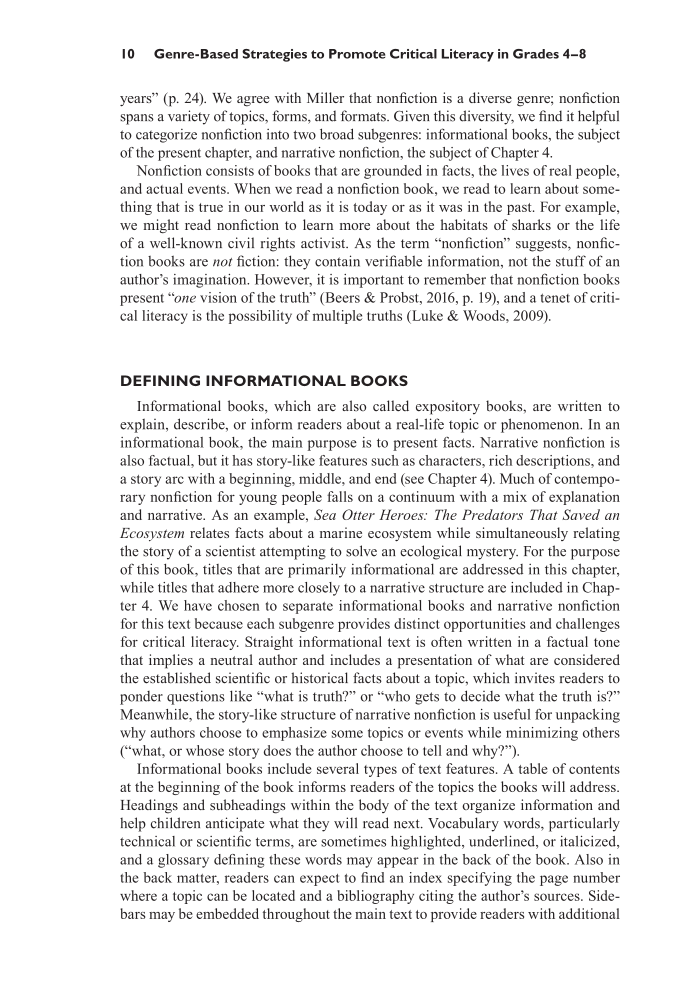10 Genre-Based Strategies to Promote Critical Literacy in Grades 4–8 years” (p. 24). We agree with Miller that nonfiction is a diverse genre nonfiction spans a variety of topics, forms, and formats. Given this diversity, we find it helpful to categorize nonfiction into two broad subgenres: informational books, the subject of the present chapter, and narrative nonfiction, the subject of Chapter 4. Nonfiction consists of books that are grounded in facts, the lives of real people, and actual events. When we read a nonfiction book, we read to learn about some- thing that is true in our world as it is today or as it was in the past. For example, we might read nonfiction to learn more about the habitats of sharks or the life of a well-known civil rights activist. As the term “nonfiction” suggests, nonfic- tion books are not fiction: they contain verifiable information, not the stuff of an author’s imagination. However, it is important to remember that nonfiction books present “one vision of the truth” (Beers & Probst, 2016, p. 19), and a tenet of criti- cal literacy is the possibility of multiple truths (Luke & Woods, 2009). DEFINING INFORMATIONAL BOOKS Informational books, which are also called expository books, are written to explain, describe, or inform readers about a real-life topic or phenomenon. In an informational book, the main purpose is to present facts. Narrative nonfiction is also factual, but it has story-like features such as characters, rich descriptions, and a story arc with a beginning, middle, and end (see Chapter 4). Much of contempo- rary nonfiction for young people falls on a continuum with a mix of explanation and narrative. As an example, Sea Otter Heroes: The Predators That Saved an Ecosystem relates facts about a marine ecosystem while simultaneously relating the story of a scientist attempting to solve an ecological mystery. For the purpose of this book, titles that are primarily informational are addressed in this chapter, while titles that adhere more closely to a narrative structure are included in Chap- ter 4. We have chosen to separate informational books and narrative nonfiction for this text because each subgenre provides distinct opportunities and challenges for critical literacy. Straight informational text is often written in a factual tone that implies a neutral author and includes a presentation of what are considered the established scientific or historical facts about a topic, which invites readers to ponder questions like “what is truth?” or “who gets to decide what the truth is?” Meanwhile, the story-like structure of narrative nonfiction is useful for unpacking why authors choose to emphasize some topics or events while minimizing others (“what, or whose story does the author choose to tell and why?”). Informational books include several types of text features. A table of contents at the beginning of the book informs readers of the topics the books will address. Headings and subheadings within the body of the text organize information and help children anticipate what they will read next. Vocabulary words, particularly technical or scientific terms, are sometimes highlighted, underlined, or italicized, and a glossary defining these words may appear in the back of the book. Also in the back matter, readers can expect to find an index specifying the page number where a topic can be located and a bibliography citing the author’s sources. Side- bars may be embedded throughout the main text to provide readers with additional
Document Details My Account Print multiple pages
Print
You have printed 0 times in the last 24 hours.
Your print count will reset on at .
You may print 0 more time(s) before then.
You may print a maximum of 0 pages at a time.




































































































































































